Tesco's Intercultural Communication Challenges and Solutions Report
VerifiedAdded on 2023/04/04
|7
|1210
|160
Report
AI Summary
This case study report examines the critical role of culture and language in business communication, focusing on the multinational company Tesco. It explores Edgard Schein's three levels of culture (artifacts, espoused values, and basic assumptions) as they apply to Tesco, highlighting the influence of culture on the organization. The report identifies significant barriers to intercultural communication within Tesco, including body language differences, varying expressions of emotions, contextual communication styles, and language barriers. It then provides recommendations to address these challenges, such as promoting cultural appreciation, encouraging empathy, and implementing cross-cultural training programs. The study emphasizes the importance of cultural diversity for innovation, effective communication, and overall productivity within the workplace, especially in a global business context. Finally, the report concludes by underscoring the crucial impact of cultural diversity and effective communication on employee productivity and overall business success, offering insights into how Tesco can overcome communication barriers and foster a more inclusive and efficient workplace.
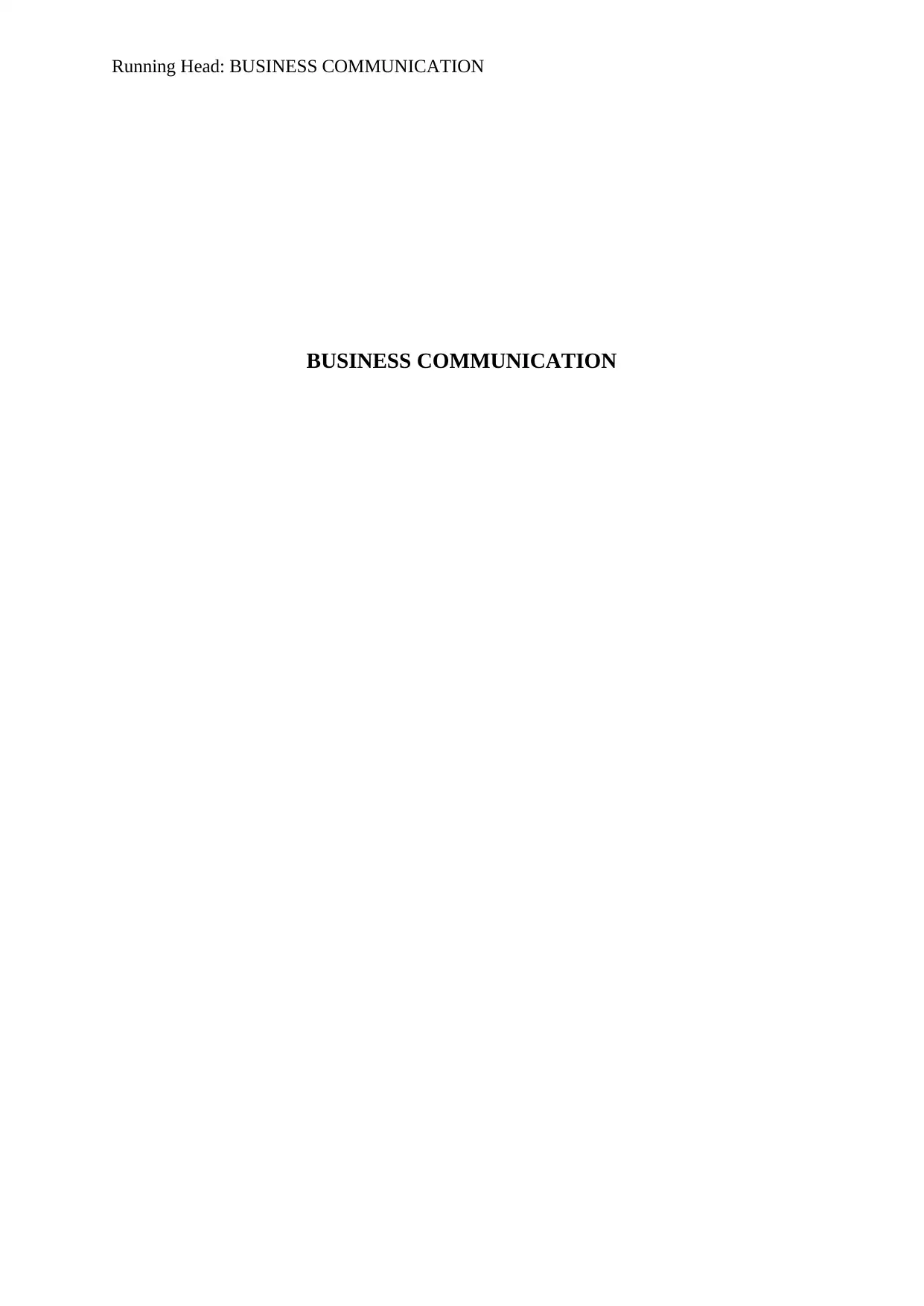
Running Head: BUSINESS COMMUNICATION
BUSINESS COMMUNICATION
BUSINESS COMMUNICATION
Paraphrase This Document
Need a fresh take? Get an instant paraphrase of this document with our AI Paraphraser
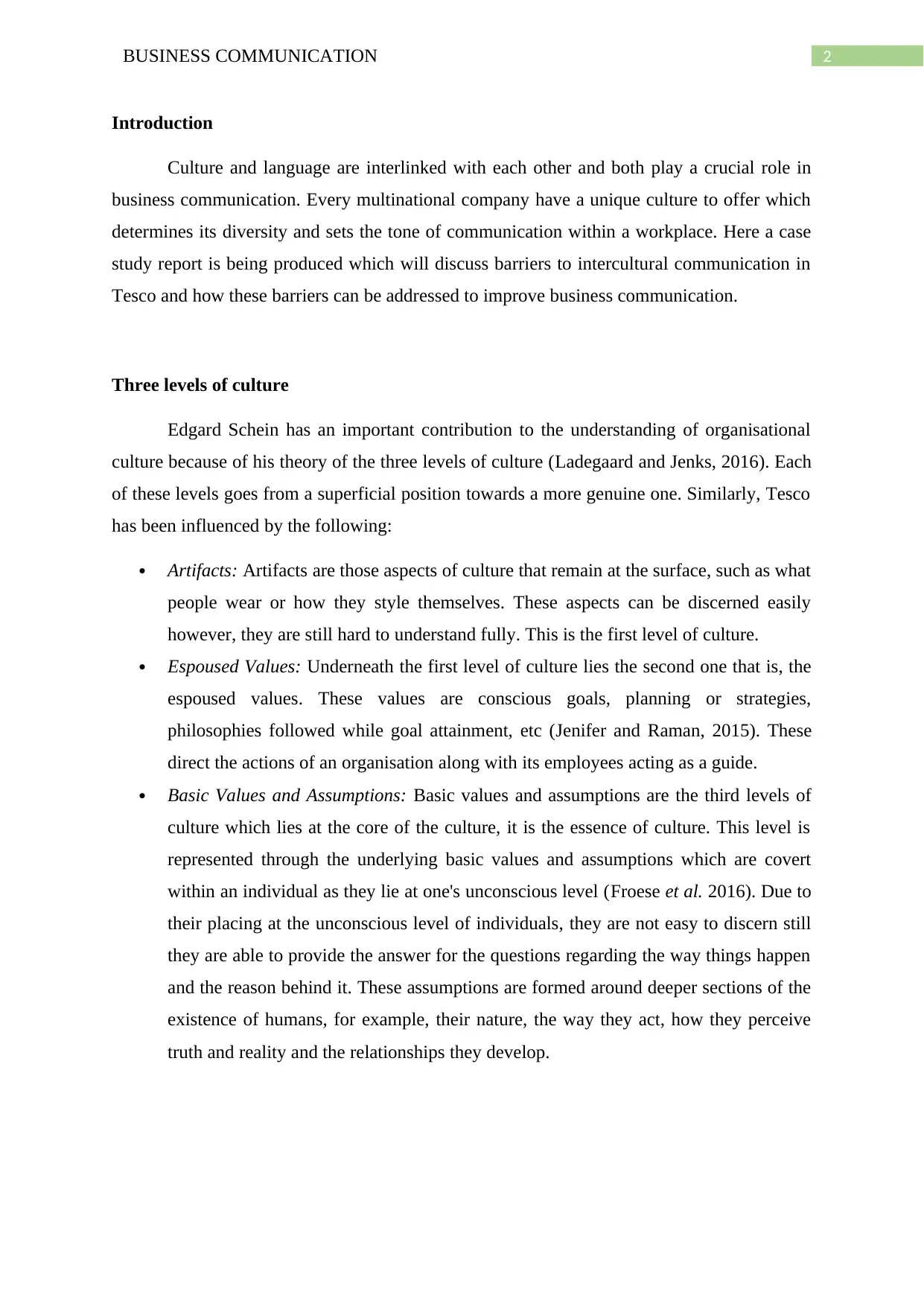
2BUSINESS COMMUNICATION
Introduction
Culture and language are interlinked with each other and both play a crucial role in
business communication. Every multinational company have a unique culture to offer which
determines its diversity and sets the tone of communication within a workplace. Here a case
study report is being produced which will discuss barriers to intercultural communication in
Tesco and how these barriers can be addressed to improve business communication.
Three levels of culture
Edgard Schein has an important contribution to the understanding of organisational
culture because of his theory of the three levels of culture (Ladegaard and Jenks, 2016). Each
of these levels goes from a superficial position towards a more genuine one. Similarly, Tesco
has been influenced by the following:
Artifacts: Artifacts are those aspects of culture that remain at the surface, such as what
people wear or how they style themselves. These aspects can be discerned easily
however, they are still hard to understand fully. This is the first level of culture.
Espoused Values: Underneath the first level of culture lies the second one that is, the
espoused values. These values are conscious goals, planning or strategies,
philosophies followed while goal attainment, etc (Jenifer and Raman, 2015). These
direct the actions of an organisation along with its employees acting as a guide.
Basic Values and Assumptions: Basic values and assumptions are the third levels of
culture which lies at the core of the culture, it is the essence of culture. This level is
represented through the underlying basic values and assumptions which are covert
within an individual as they lie at one's unconscious level (Froese et al. 2016). Due to
their placing at the unconscious level of individuals, they are not easy to discern still
they are able to provide the answer for the questions regarding the way things happen
and the reason behind it. These assumptions are formed around deeper sections of the
existence of humans, for example, their nature, the way they act, how they perceive
truth and reality and the relationships they develop.
Introduction
Culture and language are interlinked with each other and both play a crucial role in
business communication. Every multinational company have a unique culture to offer which
determines its diversity and sets the tone of communication within a workplace. Here a case
study report is being produced which will discuss barriers to intercultural communication in
Tesco and how these barriers can be addressed to improve business communication.
Three levels of culture
Edgard Schein has an important contribution to the understanding of organisational
culture because of his theory of the three levels of culture (Ladegaard and Jenks, 2016). Each
of these levels goes from a superficial position towards a more genuine one. Similarly, Tesco
has been influenced by the following:
Artifacts: Artifacts are those aspects of culture that remain at the surface, such as what
people wear or how they style themselves. These aspects can be discerned easily
however, they are still hard to understand fully. This is the first level of culture.
Espoused Values: Underneath the first level of culture lies the second one that is, the
espoused values. These values are conscious goals, planning or strategies,
philosophies followed while goal attainment, etc (Jenifer and Raman, 2015). These
direct the actions of an organisation along with its employees acting as a guide.
Basic Values and Assumptions: Basic values and assumptions are the third levels of
culture which lies at the core of the culture, it is the essence of culture. This level is
represented through the underlying basic values and assumptions which are covert
within an individual as they lie at one's unconscious level (Froese et al. 2016). Due to
their placing at the unconscious level of individuals, they are not easy to discern still
they are able to provide the answer for the questions regarding the way things happen
and the reason behind it. These assumptions are formed around deeper sections of the
existence of humans, for example, their nature, the way they act, how they perceive
truth and reality and the relationships they develop.
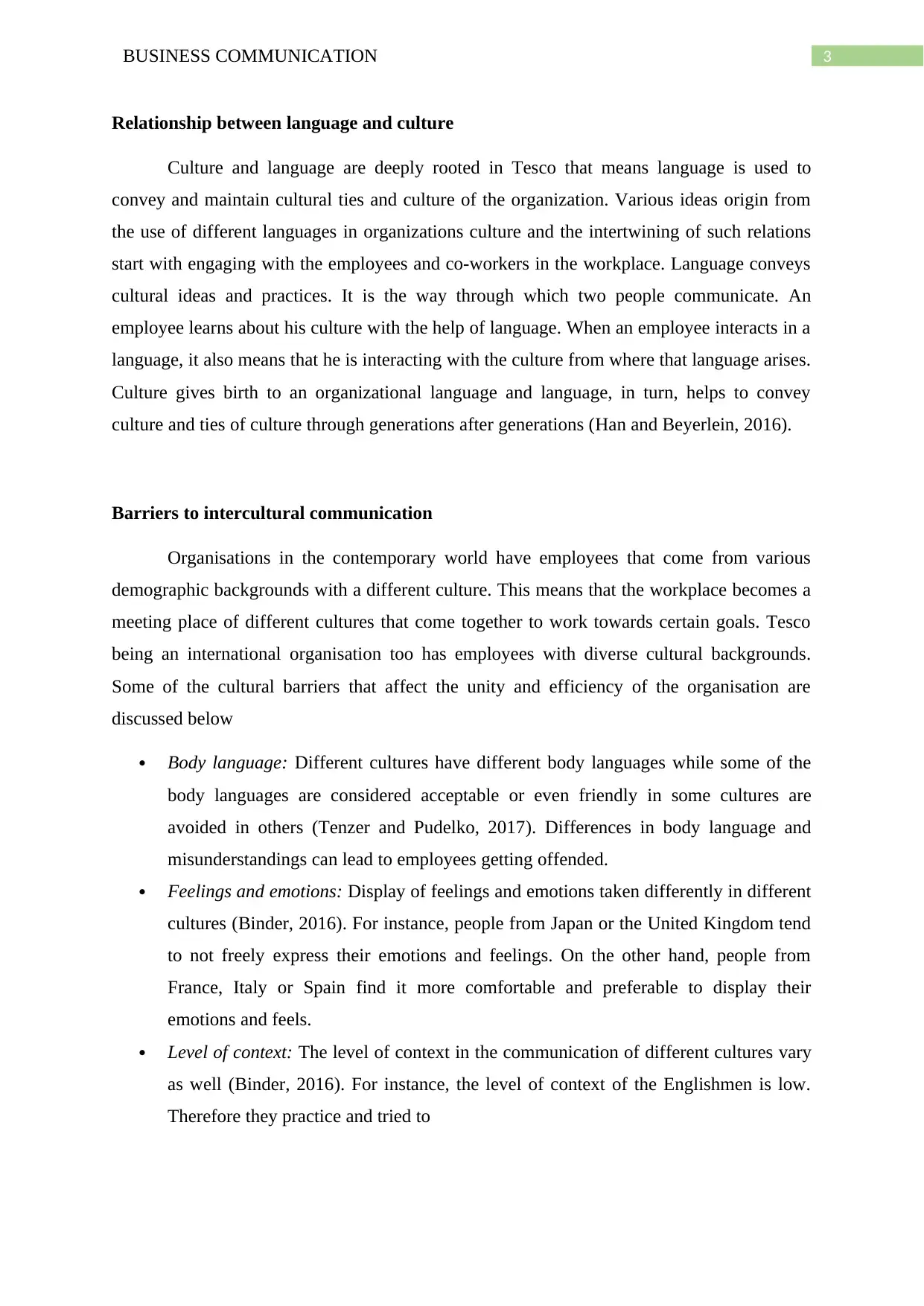
3BUSINESS COMMUNICATION
Relationship between language and culture
Culture and language are deeply rooted in Tesco that means language is used to
convey and maintain cultural ties and culture of the organization. Various ideas origin from
the use of different languages in organizations culture and the intertwining of such relations
start with engaging with the employees and co-workers in the workplace. Language conveys
cultural ideas and practices. It is the way through which two people communicate. An
employee learns about his culture with the help of language. When an employee interacts in a
language, it also means that he is interacting with the culture from where that language arises.
Culture gives birth to an organizational language and language, in turn, helps to convey
culture and ties of culture through generations after generations (Han and Beyerlein, 2016).
Barriers to intercultural communication
Organisations in the contemporary world have employees that come from various
demographic backgrounds with a different culture. This means that the workplace becomes a
meeting place of different cultures that come together to work towards certain goals. Tesco
being an international organisation too has employees with diverse cultural backgrounds.
Some of the cultural barriers that affect the unity and efficiency of the organisation are
discussed below
Body language: Different cultures have different body languages while some of the
body languages are considered acceptable or even friendly in some cultures are
avoided in others (Tenzer and Pudelko, 2017). Differences in body language and
misunderstandings can lead to employees getting offended.
Feelings and emotions: Display of feelings and emotions taken differently in different
cultures (Binder, 2016). For instance, people from Japan or the United Kingdom tend
to not freely express their emotions and feelings. On the other hand, people from
France, Italy or Spain find it more comfortable and preferable to display their
emotions and feels.
Level of context: The level of context in the communication of different cultures vary
as well (Binder, 2016). For instance, the level of context of the Englishmen is low.
Therefore they practice and tried to
Relationship between language and culture
Culture and language are deeply rooted in Tesco that means language is used to
convey and maintain cultural ties and culture of the organization. Various ideas origin from
the use of different languages in organizations culture and the intertwining of such relations
start with engaging with the employees and co-workers in the workplace. Language conveys
cultural ideas and practices. It is the way through which two people communicate. An
employee learns about his culture with the help of language. When an employee interacts in a
language, it also means that he is interacting with the culture from where that language arises.
Culture gives birth to an organizational language and language, in turn, helps to convey
culture and ties of culture through generations after generations (Han and Beyerlein, 2016).
Barriers to intercultural communication
Organisations in the contemporary world have employees that come from various
demographic backgrounds with a different culture. This means that the workplace becomes a
meeting place of different cultures that come together to work towards certain goals. Tesco
being an international organisation too has employees with diverse cultural backgrounds.
Some of the cultural barriers that affect the unity and efficiency of the organisation are
discussed below
Body language: Different cultures have different body languages while some of the
body languages are considered acceptable or even friendly in some cultures are
avoided in others (Tenzer and Pudelko, 2017). Differences in body language and
misunderstandings can lead to employees getting offended.
Feelings and emotions: Display of feelings and emotions taken differently in different
cultures (Binder, 2016). For instance, people from Japan or the United Kingdom tend
to not freely express their emotions and feelings. On the other hand, people from
France, Italy or Spain find it more comfortable and preferable to display their
emotions and feels.
Level of context: The level of context in the communication of different cultures vary
as well (Binder, 2016). For instance, the level of context of the Englishmen is low.
Therefore they practice and tried to
⊘ This is a preview!⊘
Do you want full access?
Subscribe today to unlock all pages.

Trusted by 1+ million students worldwide
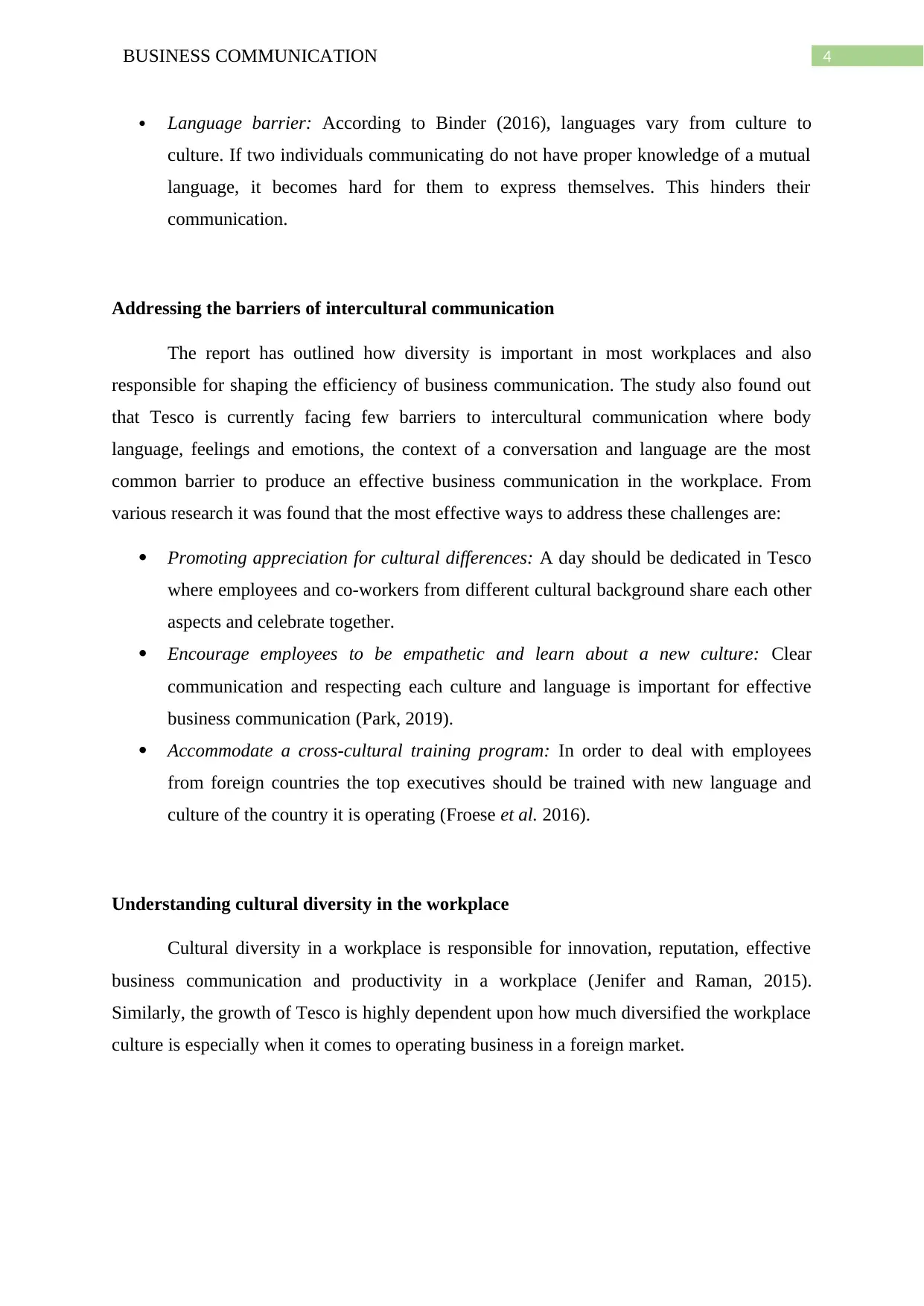
4BUSINESS COMMUNICATION
Language barrier: According to Binder (2016), languages vary from culture to
culture. If two individuals communicating do not have proper knowledge of a mutual
language, it becomes hard for them to express themselves. This hinders their
communication.
Addressing the barriers of intercultural communication
The report has outlined how diversity is important in most workplaces and also
responsible for shaping the efficiency of business communication. The study also found out
that Tesco is currently facing few barriers to intercultural communication where body
language, feelings and emotions, the context of a conversation and language are the most
common barrier to produce an effective business communication in the workplace. From
various research it was found that the most effective ways to address these challenges are:
Promoting appreciation for cultural differences: A day should be dedicated in Tesco
where employees and co-workers from different cultural background share each other
aspects and celebrate together.
Encourage employees to be empathetic and learn about a new culture: Clear
communication and respecting each culture and language is important for effective
business communication (Park, 2019).
Accommodate a cross-cultural training program: In order to deal with employees
from foreign countries the top executives should be trained with new language and
culture of the country it is operating (Froese et al. 2016).
Understanding cultural diversity in the workplace
Cultural diversity in a workplace is responsible for innovation, reputation, effective
business communication and productivity in a workplace (Jenifer and Raman, 2015).
Similarly, the growth of Tesco is highly dependent upon how much diversified the workplace
culture is especially when it comes to operating business in a foreign market.
Language barrier: According to Binder (2016), languages vary from culture to
culture. If two individuals communicating do not have proper knowledge of a mutual
language, it becomes hard for them to express themselves. This hinders their
communication.
Addressing the barriers of intercultural communication
The report has outlined how diversity is important in most workplaces and also
responsible for shaping the efficiency of business communication. The study also found out
that Tesco is currently facing few barriers to intercultural communication where body
language, feelings and emotions, the context of a conversation and language are the most
common barrier to produce an effective business communication in the workplace. From
various research it was found that the most effective ways to address these challenges are:
Promoting appreciation for cultural differences: A day should be dedicated in Tesco
where employees and co-workers from different cultural background share each other
aspects and celebrate together.
Encourage employees to be empathetic and learn about a new culture: Clear
communication and respecting each culture and language is important for effective
business communication (Park, 2019).
Accommodate a cross-cultural training program: In order to deal with employees
from foreign countries the top executives should be trained with new language and
culture of the country it is operating (Froese et al. 2016).
Understanding cultural diversity in the workplace
Cultural diversity in a workplace is responsible for innovation, reputation, effective
business communication and productivity in a workplace (Jenifer and Raman, 2015).
Similarly, the growth of Tesco is highly dependent upon how much diversified the workplace
culture is especially when it comes to operating business in a foreign market.
Paraphrase This Document
Need a fresh take? Get an instant paraphrase of this document with our AI Paraphraser
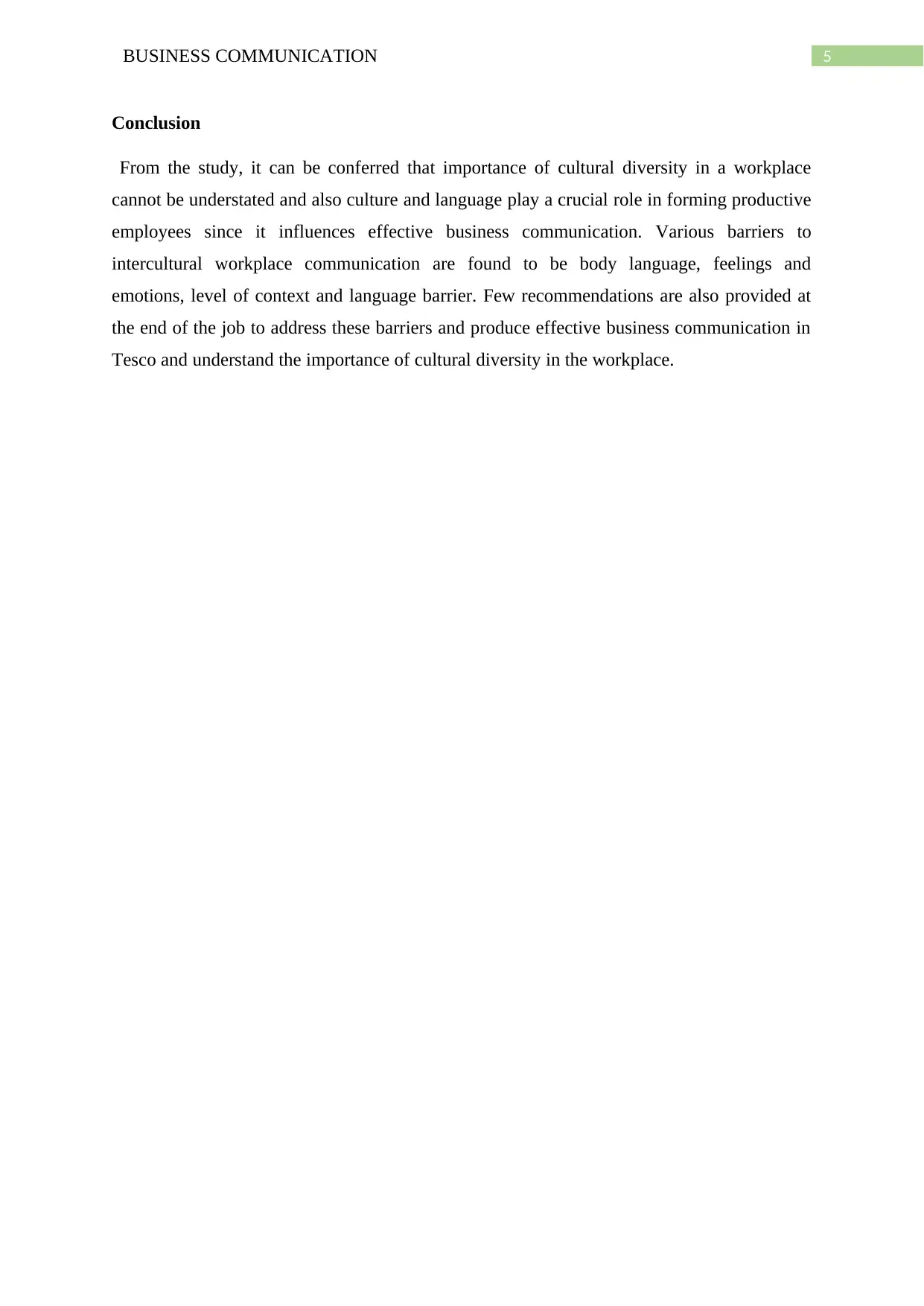
5BUSINESS COMMUNICATION
Conclusion
From the study, it can be conferred that importance of cultural diversity in a workplace
cannot be understated and also culture and language play a crucial role in forming productive
employees since it influences effective business communication. Various barriers to
intercultural workplace communication are found to be body language, feelings and
emotions, level of context and language barrier. Few recommendations are also provided at
the end of the job to address these barriers and produce effective business communication in
Tesco and understand the importance of cultural diversity in the workplace.
Conclusion
From the study, it can be conferred that importance of cultural diversity in a workplace
cannot be understated and also culture and language play a crucial role in forming productive
employees since it influences effective business communication. Various barriers to
intercultural workplace communication are found to be body language, feelings and
emotions, level of context and language barrier. Few recommendations are also provided at
the end of the job to address these barriers and produce effective business communication in
Tesco and understand the importance of cultural diversity in the workplace.
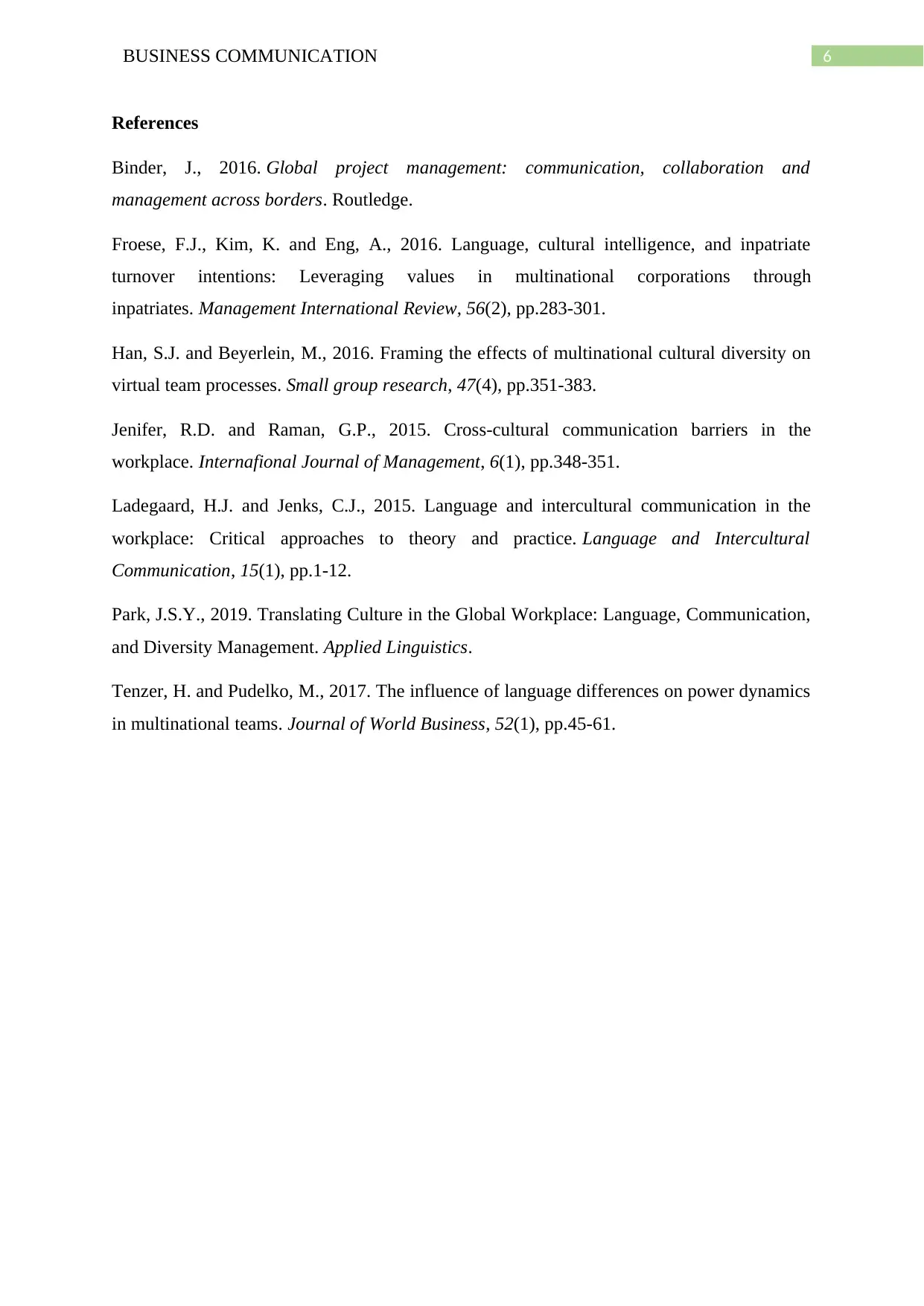
6BUSINESS COMMUNICATION
References
Binder, J., 2016. Global project management: communication, collaboration and
management across borders. Routledge.
Froese, F.J., Kim, K. and Eng, A., 2016. Language, cultural intelligence, and inpatriate
turnover intentions: Leveraging values in multinational corporations through
inpatriates. Management International Review, 56(2), pp.283-301.
Han, S.J. and Beyerlein, M., 2016. Framing the effects of multinational cultural diversity on
virtual team processes. Small group research, 47(4), pp.351-383.
Jenifer, R.D. and Raman, G.P., 2015. Cross-cultural communication barriers in the
workplace. Internafional Journal of Management, 6(1), pp.348-351.
Ladegaard, H.J. and Jenks, C.J., 2015. Language and intercultural communication in the
workplace: Critical approaches to theory and practice. Language and Intercultural
Communication, 15(1), pp.1-12.
Park, J.S.Y., 2019. Translating Culture in the Global Workplace: Language, Communication,
and Diversity Management. Applied Linguistics.
Tenzer, H. and Pudelko, M., 2017. The influence of language differences on power dynamics
in multinational teams. Journal of World Business, 52(1), pp.45-61.
References
Binder, J., 2016. Global project management: communication, collaboration and
management across borders. Routledge.
Froese, F.J., Kim, K. and Eng, A., 2016. Language, cultural intelligence, and inpatriate
turnover intentions: Leveraging values in multinational corporations through
inpatriates. Management International Review, 56(2), pp.283-301.
Han, S.J. and Beyerlein, M., 2016. Framing the effects of multinational cultural diversity on
virtual team processes. Small group research, 47(4), pp.351-383.
Jenifer, R.D. and Raman, G.P., 2015. Cross-cultural communication barriers in the
workplace. Internafional Journal of Management, 6(1), pp.348-351.
Ladegaard, H.J. and Jenks, C.J., 2015. Language and intercultural communication in the
workplace: Critical approaches to theory and practice. Language and Intercultural
Communication, 15(1), pp.1-12.
Park, J.S.Y., 2019. Translating Culture in the Global Workplace: Language, Communication,
and Diversity Management. Applied Linguistics.
Tenzer, H. and Pudelko, M., 2017. The influence of language differences on power dynamics
in multinational teams. Journal of World Business, 52(1), pp.45-61.
⊘ This is a preview!⊘
Do you want full access?
Subscribe today to unlock all pages.

Trusted by 1+ million students worldwide

7BUSINESS COMMUNICATION
References
References
1 out of 7
Related Documents
Your All-in-One AI-Powered Toolkit for Academic Success.
+13062052269
info@desklib.com
Available 24*7 on WhatsApp / Email
![[object Object]](/_next/static/media/star-bottom.7253800d.svg)
Unlock your academic potential
Copyright © 2020–2025 A2Z Services. All Rights Reserved. Developed and managed by ZUCOL.





